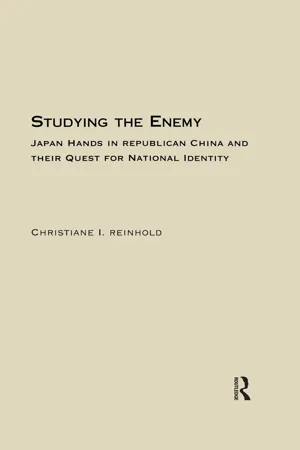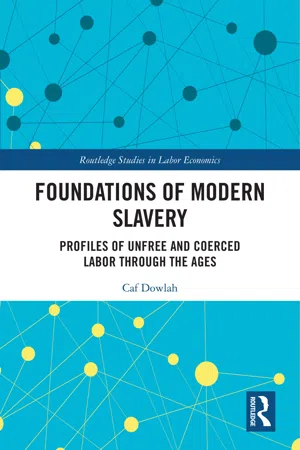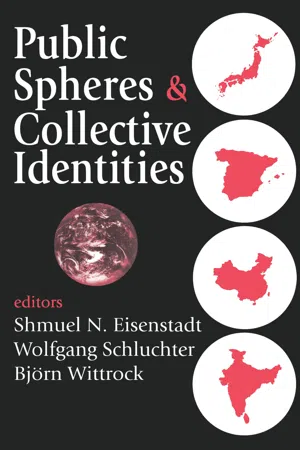History
Daimyo
Daimyo were powerful feudal lords in Japan during the pre-modern era, from the 12th to the 19th century. They controlled vast land holdings and maintained their own samurai warriors. The daimyo played a significant role in shaping Japan's political and social structure, often engaging in power struggles and alliances with each other and the central government.
Written by Perlego with AI-assistance
Related key terms
7 Key excerpts on "Daimyo"
- eBook - ePub
- Harald Kleinschmidt(Author)
- 2017(Publication Date)
- Routledge(Publisher)
In quick succession Japan came under the dominance of a few powerful overlords who grasped control of large regional coalitions of Daimyo, and then between 1582 and 1590 under a national hegemony of Daimyo led by Toyotomi Hideyoshi. The movement towards centralization on the national level was matched by a similar integration process within the Daimyo domains. In particular, the Daimyo in order to achieve more effective adminstration of their territories, began to eliminate the small fiefs into which their domains had been subdivided. The great civil wars which engulfed Japan from the 1530's through 1590 and which culminated in the formation of a new national hegemony gave rise to conditions which served to eliminate the most typical feudal practices from many sectors of Japanese society. Ironically, when Japan was for the first time brought completely under the rule of "feudal lords", those very lords had begun to divest themselves of the most fundamentally feudal aspects of their means of governance. 42 The Tokugawa regime, established in 1603 with its headquarters at Edo, rested at least superficially upon a fulfillment of some of the trends which we have traced up to now as indices of the growth of feudal practices in Japan. The entire country was now governed by Daimyo who in turn were the shogun's vassals. The "military band" had by now apparently taken over the entire operation of government. Furthermore, the seemingly artificial efforts of the Tokugawa regime to create a closed caste out of the samurai and to tie the peasantry to the land, support the view that Japan was at long last feudal through and through. 43 Historians have recognized, however, the danger of too sweeping a characterization of Tokugawa Japan as feudal. Most writers have tended to soften their judgment by referring to the Tokugawa age as a period of "late feudalism", "centralized feudalism", or "national feudalism" - eBook - ePub
Japanese Family and Society
Words from Tongo Takebe, A Meiji Era Sociologist
- Phil Barker, Teruhito Sako, Suzanne K Steinmetz(Authors)
- 2007(Publication Date)
- Routledge(Publisher)
daimyō , lower-ranking samurai, farmers, and merchants) followed prescribed traditions that ranged from payment of taxes to duties at court—a place for everyone and everyone in his or her place. Entrenched in a feudal, agricultural-based economy, this system became dysfunctional as a money economy controlled by the merchant class emerged.Maintaining control . The goal of the Tokugawa shogunate was maintaining the peace and the stability of the government, as well as the entire nation (Yokota, 2002). The daimyō who had their own governments with local warrior armies and courts, and the ability to levy taxes controlled about 75 percent of the land; the Tokugawa family had direct control over about 25 percent of the land. Thus the shogun, as a national ruler, had the difficult task of obtaining and maintaining control. One such mechanism, noted above, was moving samurai off their land and into castle towns. They were no longer a landed class but urban citizens who served as officials in the shogunal or daimyō bureaucracies. Their income was now based on stipends paid by the local daimyō , not the rents collected from the peasant farmers. Furthermore, although they were not required to pay direct taxes to the shogunate, they were expected to contribute to the building and repair of various shogunate projects, such as castles and shrines.Perhaps the greatest control was exercised through sankin-kohai , the system of alternate attendance, which required the daimyō lord of each han to reside in Edo for a period of time (typically every six months or alternate years). Certain high-ranking daimyō , including the heads of the three main Tokugawa families (the Owari, the Kii, and the Mito), had to reside in Edo permanently (Cunnigham, 2004). The legitimate heirs, all sons and the first wives, were required to permanently reside in Edo as political hostages. Not only did this require heavy expenditures for the lords and their family, the elaborate court rules extended to the various subjects who attended the daimyō (Jansen, 1971). Most daimyō lords built permanent residents in Edo to reduce the massive travel expenses and left the governing of their own territories to their local regents or ministers back home (called Jodai-garo ). Thus, by the mid- to late-Edo period, the original purpose of the sankin-kohtai - eBook - ePub
Studying the Enemy
Japan Hands in Republican China and Their Quest for National Identity, 1925-1945
- Christiane Reinhold(Author)
- 2018(Publication Date)
- Routledge(Publisher)
To keep the daimyô in check, the Tokugawa built and elaborated on measures Toyotomi Hideyoshi already had put in place to prevent any challenge to the central authority. The rank and position of the daimyô was assigned in accordance with the productivity of the land they controlled. Those with an income of over 10,000 dan were considered an economically independent unit, a domain. 71 While the daimyô enjoyed free rein within their domain, they were required to provide so-called "hostages," members of their family, who had to reside in Edo. 72 Following Toyotomi Hideyoshi's example, the Tokugawa rulers froze the social classes by profession, and in accordance with the Chinese model divided the Japanese society into four classes: the bushi, the peasantry, the artisans, and the merchants. Intermarriage between the different classes was outlawed. 73 Hereditary social stratification was not something entirely new to the Japanese. Xie Jinqing asserted that from pre-historical times, Japanese society was class-based. The rigid social structure under the Tokugawa appeared thus as an imaginary endpoint of tendencies that had existed for centuries. Xie believed that the Japanese commonly thought in terms of complex social divisions, segregation, and hierarchy. Over time, the strong sense of class division grew more defined. Whereas the Yamato tribe had conceived of their society primarily in terms of ethnic divides which juxtaposed the Yamato family, Koreans, Chinese émigrés, and the native tribes the Yamato had vanquished and absorbed, the arrival of feudal Japan and the rise of the samurai had produced a much refined system. 74 Xie distinguished six different classes in feudal, pre-Tokugawa Japan: the imperial family, military leaders and feudal lords, samurai, peasants, merchants, and outcast(e)s (hinin). The samurai or bushi occupied the same high social position as did the candidates who had qualified themselves for appointment in the Chinese civil service system - eBook - ePub
Voices of Early Modern Japan
Contemporary Accounts of Daily Life During the Age of the Shoguns
- Constantine N. Vaporis, Constantine Nomikos Vaporis(Authors)
- 2020(Publication Date)
- Routledge(Publisher)
This was closely related to the term bakuhan seido, or “system of the bakufu (shogunate) and domains,” favored by Japanese historians. More recently, other Western historians have described it as an “integrated yet decentralized state structure” or a “compound state,” the latter term emphasizing the autonomy of the Daimyo commanding large domains in the peripheries of Japan. Other scholars prefer the term “Tokugawa state” to emphasize that the shogunate was the state and that its power and authority was analogous to the “absolute states” of early modern Europe, such as France and England in the seventeenth and eighteenth centuries. James White, in particular, has argued that the Tokugawa state grew in “stateness,” maintaining a monopoly on the exercise of legitimate force, meaning that the shogunate maintained an exclusive right to use force against the Daimyo. The lords, however, could not use force among themselves, nor could they do so at will against their own people. While it is true that the Daimyo faced no regular exactions other than the alternate attendance and had great latitude in ruling the domains under their control—as long as they followed the laws of Edo—their positions remained conditional on Tokugawa authority. As noted above, the total range of controls the Tokugawa exercised over the Daimyo was quite impressive, and even the largest and most distant domains obeyed Tokugawa demands to contribute to costly riparian works, such as the construction of river dikes, to compile at the shogunate’s demand an annual census and survey of religious sectarian affiliation (shūmon aratame chō), to provide information to the shogunate for the compilation of national maps, not to mention to perform faithfully the alternate attendance. The central highway network, the Gokaidō, was maintained at Daimyo expense, but was Tokugawa territory and under its control, regardless of the domain through which the roads coursed - eBook - ePub
Foundations of Modern Slavery
Profiles of Unfree and Coerced Labor Through the Ages
- Caf Dowlah(Author)
- 2021(Publication Date)
- Routledge(Publisher)
In many respects, however, Japan had its own variant of feudalism. After all, unlike West European monarchs, Japanese shoguns did not represent a weak central authority. The bakufu —the central government of the Shogunate—exercised strong bureaucratic authority all over Japan and had absolute political power over the hans (local governments), and they could even remove them. The Shoguns granted the Daimyos the land to rule in exchange of their absolute loyalty to them, and disobedience was severely crushed. Also, the Japanese vassalage did not involve contractual relations as was the case in Western Europe. Moreover, unlike in Western Europe, Japanese farmers were not tied to land—they belonged to the assigned land, but their mobility was not restricted, and they did not need passports from their manorial masters to move to other areas. Peasants formed a distinct class, but they were deemed higher in ranks than merchants and traders in the society. Peasants had no service obligations to manorial owners either. By the middle of the Tokugawa Shogunate, farmers became exclusive owners of their land, they had wide freedom to choose their crops and ran their affairs through self-government, and they paid their taxes in a fixed amount, and rich peasants often hired tenant farmers to cultivate their land. The Japanese feudal system also maintained a high degree of social mobility, despite the classification of the population based on economic status. The socio-economic progression of the peasants was fluid as well—many rich peasants became commercial agricultural producers. The feudalism also gave rise to a powerful merchant class, and their prominence was accompanied by simultaneous decline of the power of the nobility. Many of the samurais and Daimyos joined the merchant class, becoming bankers, manufacturers, and other types of entrepreneurs - eBook - ePub
- Walter Lippmann(Author)
- 2018(Publication Date)
- Routledge(Publisher)
22Tokugawa Feudalism
The distinctiveness of Tokugawa Japan’s internal political organization has fostered lively debate concerning the nature of the early modern Japanese state. The difficulty historians have had in arriving at a consensus is reflected in the abundance of terms they have invoked to describe it: Western scholars have recently suggested such concepts as “federalism,” “absolutism,” “flamboyant state,” and “compound state.”23 This ongoing debate over terms reflects historians’ dissatisfaction with the concept of “feudalism,” which at one time was the focus of Western and Japanese scholarship on the early modern Japanese state.24 Western scholars now generally eschew the term entirely or use it in a limited sense to refer to the ties of vassalage that bound the samurai, including the Daimyo, to their lords and to the shogun.At the risk of appearing hopelessly old-fashioned, I should like to make a case here for feudalism as an analytical category, understood in the Marxian sense as a mode of production. Rodney Hilton has defined the feudal mode of production as being characterized by an “exploitative relationship between landowners and subordinated peasants, in which the surplus beyond subsistence of the latter, whether in direct labor or in rent in kind or in money, is transferred under coercive sanction to the former.”25 This admittedly sweeping definition, applied mechanically to Japan, does misrepresent the political economy of the Tokugawa period insofar as the authorities quickly lost the ability—if indeed they ever really had it—to expropriate effectively the entire surplus value of peasant production. Nevertheless, if a mode of production is seen as a kind of genetic coding, in terms of which political, social, and economic institutions are articulated, this conception of feudalism does help us to understand the logic underlying the Tokugawa system. That is, the institutional structure was designed to support the military and administrative needs of the regime through the expropriation of agricultural surplus as expressed through the kokudaka system, which served as the means to calculate taxation and the domains’ military obligations to the shogunate.26 Whether the kokudaka - Michael Smitka(Author)
- 1998(Publication Date)
- Routledge(Publisher)
Local landholders, known as myōshu, were the principal cultivators, and they paid an annual land rent to the estate’s proprietors, most often temples or aristocratic families in Kyoto. These local landholders possessed legally protected entitlements to their lands, including the right to buy, sell, and bequeath their holdings. Landownership was transferable not only between fellow land-holders but also to officials of the shogunate such as the military estate stewards (jitō), some of whom might reside within the boundaries of any given estate and ultimately become the vassals of that estate’s proprietors. At this time in the Tōkai region, small-scale private land-holders, who also constituted a portion of the lower stratum of the warrior class, were referred to as kumon, or native estate officers. Like the myōshu these men could buy and sell land, expand agricultural production, and open markets. Many of the landholders of the medieval period had to fight when called upon by the Daimyo with whom they had entered an alliance. To this end, members of this landowning warrior class were expected to supply their own provisions and military equipment and to lead their own retainers into battle. Moreover, this upper stratum of warrior-villagers also managed groups of “vassal peasants” (hikan-byakushO), who in peacetime worked land leased from the samurai but who in time of war accompanied their samurai masters into battle. More numerous were the villagers called jige-byakushō, men who engaged solely in agriculture under the direction of the myōshu and kumon but who were not required to fulfill any military service obligation
Learn about this page
Index pages curate the most relevant extracts from our library of academic textbooks. They’ve been created using an in-house natural language model (NLM), each adding context and meaning to key research topics.






